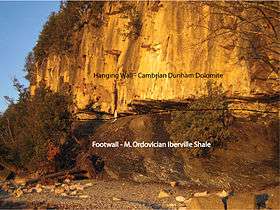Lone Rock Point

Lone Rock Point is an promontory north of Burlington, Vermont and on the eastern shore of Lake Champlain.[1] It is publicly accessible via a trail network and sits on land owned by the Episcopal Diocese of Vermont.[2]
The site is of geologic significance for its spectacular exposure of a thrust contact between the Cambrian-aged Dunham Dolostone and the Middle-Ordovician Iberville Shale. The thrust fault exposed at this location is regionally called the Champlain Thrust which formed during the Taconic Orogeny.[3] At this site, the stratigraphic throw of the Champlain Thrust measures about 8,850 feet.[4]
The site is arguably the most visited structural geology feature in all of New England[5] and is featured in many structural geology text books as a classic example of a thrust fault.[6][7]
Dunham Formation at Lone Rock Point
The Dunham Formation is a Cambrian dolostone that is exposed in the hanging wall of the Champlain Thrust Fault at Lone Rock Point. This unit was initially deposited in a warm, shallow sea environment as a platform carbonate. Well-exposed mullions at the base of the dolomite plunge about 15 degrees southeast, indicating transport direction (headed toward the modern lake.)[4] The light colored rocks along the shoreline are dolostones that have fallen after the shale eroded away.[8]
Iberville Shale at Lone Rock Point
The Ordovician Iberville Shale was likely deposited in a deeper marine environment and consists of fine-grained clastic materials.[1] Slip surfaces within the Iberville Shale seen at Lone Rock Point often contains calcite slickenlines along the planar thrust surface.[4] Overlying pressure has led to a high degree of vertical faulting and calcite dissolution (white banding) throughout the unit.[4] The top-most layer of the shale has been eroded away.[8]
References
- ↑ "The Champlain Thrust…what is it?". University of Vermont Department of Geology. Retrieved 25 April 2016.
- ↑ "The Rock Point Center: About Us". Episcopal Diocese of Vermont. Retrieved 25 April 2016.
- ↑ Share, Dr Jack (2011-10-24). "Written In Stone...seen through my lens: Part II: Geological Observations by Land and Sea of the Champlain Thrust Fault at Lone Rock Point". Written In Stone...seen through my lens. Retrieved 2016-02-29.
- 1 2 3 4 Stanley, Rolf (1987). "The Champlain Thrust Fault, Lone Rock Point, Burlington, Vermont" (PDF). Geological Society of America Centennial Field Guide - Northeastern Section.
- ↑ Lone Rock Point GSA DNAG field trip #50, Stanley, R., 1987, The Champlain Thrust Fault, Lone Rock Point, Burlington, VT, GSA Centennial Field Guide, Northeastern Section pp. 225-227.
- ↑ Hatcher, R.D. Jr., Structural Geology: Principles Concepts and Problems., 1990., Prentice Hall
- ↑ Billings, M. p., 1972, Structural Geology (3rd Ed.); Prentice-Hall, 606 p.
- 1 2 Johnson, Charles W. (2000-09-26). The Nature of Vermont: Introduction and Guide to a New England Environment. UPNE. ISBN 9781611681314.
Coordinates: 44°29′25″N 73°14′55″W / 44.490309°N 73.248739°W